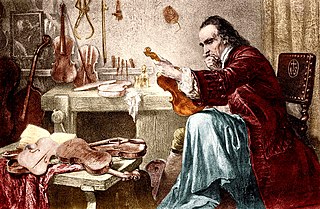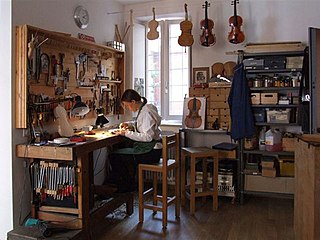Related Research Articles

Antonio Stradivari was an Italian luthier and a craftsman of string instruments such as violins, cellos, guitars, violas and harps. The Latinized form of his surname, Stradivarius, as well as the colloquial Strad are terms often used to refer to his instruments. It is estimated that Stradivari produced 1,116 instruments, of which 960 were violins. Around 650 instruments survive, including 450 to 512 violins. His instruments are considered some of the finest ever made, and are extremely valuable collector's items.

Cremona is a city and comune in northern Italy, situated in Lombardy, on the left bank of the Po river in the middle of the Pianura Padana. It is the capital of the province of Cremona and the seat of the local city and province governments. The city of Cremona is especially noted for its musical history and traditions, including some of the earliest and most renowned luthiers, such as Giuseppe Guarneri, Antonio Stradivari, Francesco Rugeri, Vincenzo Rugeri, and several members of the Amati family.
The Guarneri, often referred to in the Latinized form Guarnerius, is the family name of a group of distinguished luthiers from Cremona in Italy in the 17th and 18th centuries, whose standing is considered comparable to those of the Amati and Stradivari families.
Jacob Stainer was the earliest and best known Austrian and Germanic luthier. His violins were sought after by famous 17th- and 18th-century musicians and composers including Johann Sebastian Bach, Wolfgang Amadeus Mozart and George Simon-Lohein.
Nicolò Gagliano, although there is some discussion about the exact dates), was an Italian violin-maker, the eldest son of Alessandro Gagliano. He made many admirable instruments, often imitated. Some have been mistaken for those of Stradivari. Nicolò was a more prolific maker than his brother Gennaro (Januarius). Nicolò and Gennaro are considered the greatest luthiers in the Gagliano family and the pinnacle of Neapolitan violin-making. Although Nicolò's work is not always entirely consistent in quality, it often shows great distinction. His instruments have bold and well-proportioned archings, with the instrument scrolls having a distinctive elongated pegbox and small tight spiral. He often placed a small label with a religious dedication inside his instruments.

Gagliano is the name of a famous family of Italian luthiers from Naples, dating back to the early 18th century. The Gagliano dynasty – particularly Alessandro, Nicolò I and Gennaro – are considered the high point of Neapolitan violin making. There are as many as eighteen Gagliano violin makers known worldwide today. Below is a family tree of a few of its most recognizable luthiers.

Giovanni Paolo Maggini, was a luthier born in Botticino (Brescia), Italy. Maggini was a pupil of the most important violin maker of the Brescian school, Gasparo da Salò.
Francesco Rugeri, also known as Ruger, Rugier, Rugeri, Ruggeri, Ruggieri, Ruggerius, was the first of an important family of luthiers, the Casa Rugeri in Cremona, Italy. His instruments are masterfully constructed. His violins are inspired by Nicolò Amati's "Grand Amati" pattern. Francesco was the first to develop a smaller cello design, which has become the standard for modern cello dimensions. Today, Rugeri's instruments are nearly as renowned as Nicolò Amati's instruments.
Sanctus Seraphin, also known as Santo Serafin, was a successful luthier, working in Venice. He closed his bottega (workshop) in 1741 but he continued to work in the bottega of Giorgio Serafin, his nephew, till his death in 1776. It is still unknown where he learned the art of violin making. His models were inspired to the Cremonese luthier Nicolò Amati.
Andrea Guarneri was an Italian luthier, musician and founder of the Casa Guarneri. He is the most important student of Nicola Amati and grandfather of one of the best luthiers, Bartolomeo Giuseppe Guarneri, del Gesù.

The Voller Brothers, William, Alfred and Charles, were craftsmen who worked in Streatham, London, from 1885 to 1927 and are best known for their imitations of fine violins and the infamous "Balfour" Stradivarius.
Pietro Giovanni Guarneri (1655–1720), also known as Pietro da Mantua or Peter Guarnerius of Mantua was a violin maker of the Guarneri family who also worked as a professional musician. Today his instruments are highly regarded, though quite rare. They are played by musicians such as Joseph Szigeti.
Giuseppe Giovanni Battista Guarneri, better known as Giuseppe filius Andrea Guarneri was a violin maker from the prominent Guarneri family of luthiers who lived in Cremona, Italy.

Lorenzo Storioni is considered one of the last of the classic Cremonese master violin makers/luthiers of the 18th century.

Nicola Amati, Nicolò Amati or Nicolao Amati was an Italian master luthier from Cremona, Italy. Amati is one of the most well-known luthiers from the Casa Amati. He was the teacher of illustrious Cremonese School luthiers such as Andrea Guarneri and Giovanni Battista Rogeri. While no clear documentation exists for their being apprentices in his shop, Amati may also have apprenticed Antonio Stradivari, Francesco Rugeri, and Jacob Stainer, as their work is heavily influenced by Amati.
Giovanni Rota apprenticed under the influential Italian luthier Lorenzo Storioni from approximately 1787 to 1792, and spent his later years between Cremona and Mantua as a luthier. Not much about Giovanni's early life is known, save for his apprenticeship under this famous luthier. He was born in Cremona, Italy which at the time was under control of the Austrian Empire, and was in close contact with Giovanni Battista Ceruti, who was also apprenticed under Lorenzo Stiorini.

The Traditional violin craftsmanship in Cremona was declared an intangible cultural heritage by UNESCO in 2012, during the 7th session of the Intergovernmental Committee in Paris. The Cremona's traditional violin making is an ancient form of handicraft typical of Cremona (Italy) where bowed string instruments like violins, violas, cellos and double basses have been made since the 16th century.

The Violin Museum is a musical instrument museum located in Cremona. The museum is best known for its collection of stringed instruments that includes violins, violas, cellos and double basses crafted by renowned luthiers, including Antonio Stradivari and Giuseppe Guarneri del Gesù.
Vincenzo Rugeri, was an Italian luthier of string instruments such as violins, cellos, and, violas in Cremona, Italy. His instruments are noted for their craftsmanship and tone quality. Vincenzo came from a distinguished family of luthiers, the first of whom was his father, Francesco Rugeri. Despite the local tradition of artisan families laboring together through generations, Vincenzo left the family shop and set up a successful shop of his own in the center of Cremona. Vincenzo was the third son of luthier Francesco Rugeri. Vincenzo's work, like Francesco's, is influenced by Nicolò Amati's Grand Pattern model, however Vincenzo's work was distinguished from his father's by utilizing a lower arch inspired by Antonio Stradivari. An analysis of the body of his work reveals that the quality of Vincenzo's instruments is remarkable, perhaps even more so than his father's. Vincenzo's instruments, though less numerous, are valued at least equal to those of his father. A violin by Vincenzo Rugeri realized $502,320 on October 3, 2011 at Brompton's Auctions in London. Carlo Bergonzi was a distinguished apprentice of Vincenzo Rugeri.
John Mackintosh or John McIntosh was an Irish luthier and professor who worked in Dublin. Towards the end of his career, he wrote a short publication on violin making and the Cremonese school. One of his violins is preserved as part of a collection at the National Museum of Ireland, Dublin.
References
- 1 2 3 4 John Dilworth. "John Dilworth Explores the Craftsmanship of Tommaso Balestrieri". Ingles & Hayday. Archived from the original on October 17, 2016. Retrieved November 26, 2016.
- 1 2 3 "From the Archive: a violin by Tomasso Balestrieri". The Strad. April 27, 2015. Archived from the original on November 26, 2016. Retrieved November 26, 2016.
- 1 2 3 4 5 6 John Dilworth (January 15, 2014). "Tomasso Balestrieri". Brompton's. Archived from the original on November 26, 2016. Retrieved November 26, 2016.
- ↑ "Tomasso Balestrieri". sparebankstiftelsen.no. Archived from the original on November 26, 2016. Retrieved November 26, 2016.
- ↑ "John Dilworth – biography". johndilworthviolins.co.uk. Archived from the original on October 24, 2016. Retrieved November 26, 2016.